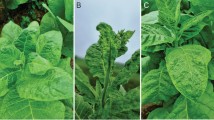Abstract
Through high-throughput sequencing, a novel citlodavirus, tentatively named “Myrica rubra citlodavirus 1” (MRV1, accession no. OP374189), was isolated from the leaves of Myrica rubra in Yunnan exhibiting narrow deformity of leaf tips, shrinkage, and chlorosis along the veins. The complete genome sequence was determined and analyzed using cloning and Sanger sequencing. MRV1 is a single-stranded circular non-enveloped DNA virus with a genome size of 3775 nucleotides and contains six open reading frames (ORFs). The virion-sense genome strand encodes a coat protein (CP, nt 750-1,493, 247 aa), two hypothetical movement proteins (V3, nt 382–666, 94 aa; and V2, nt 461–895, 144 aa), and one movement protein (MP, nt 1,527-2,438, 303 aa). The complementary strand of the genome encodes two replication proteins (RepA, nt 3,712-2,834, 292 aa; Rep, nt 2,867-2,553, 104 aa). The MRV1 genome contains the stem-loop motif 5′-TAATATTAC-3′, which is a highly conserved nonanucleotide motif found in the origin of virion-strand replication in geminiviruses. Genome sequence alignment analysis showed that citrus chlorotic dwarf associated virus (CCDaV, accession no. JQ920490) shared the highest nucleotide sequence similarity (66.10% identity) with MRV1. Phylogenetic analysis showed that CCDaV is the closest known relative of MRV1, and that these viruses clustered in a single branch within a clade consisting of citlodaviruses. These results indicate that MRV1 should be regarded as a new species of the genus Citlodavirus in the family Geminiviridae.


Similar content being viewed by others
Data availability
The dataset generated during the current study is available in the GenBank database (accession no. OP374189).
References
Wu YM, Chen J, Li WF et al (2007) Comprehensive research and utilization of Myrica rubra. Food Sci Tech-Brazil 32(10):75–78
Zhang X, Lv Q, Jia S et al (2016) Effects of favonoid-rich Chinese bayberry (Morella rubraSieb.Et Zucc.) fruit extract on regulating glucose and lipid metabolism in diabetic kk-Ay mice. Food Funct 7(7):3130–3140
Yao WR, Wang HY, Wang ST et al (2011) Assessment of the antibacterial activity and the antidiarrheal function of flavonoids from bayberry fruit. J Agric Food Chem 59(10):5312–5317
He HY, Huang L, Wu SP et al (2019) Occurrence and damage of major diseases of Myrica rubra fruits and their pathogenic morphology identification. Guizhou Agricultural Sciences 47(05):43–45
Wang Z (2013) Survey on diseases of Myrica rubra in Cixi and identification of main pathogenic species and disease control. Yangzhou University
Chen F, Pu Z, Ni H et al (2021) Multiple mycoviruses identified in Pestalotiopsis spp. from Chinese bayberry. Virol J 18(1):43
Varsani A, Roumagnac P, Fuchs M et al (2017) Capulavirus and Grablovirus: two new genera in the family Geminiviridae. Arch Virol 162:1819–1831
Zerbini FM, Briddon RW, Idris A et al (2017) ICTV virus taxonomy profle: Geminiviridae. J Gen Virol 98:131–133
Varma A, Malathi VG (2015) Emerging geminivirus problems: a serious threat to crop production. Ann Appl Biol 142:145–164
Jeske H (2009) Geminiviruses. Curr Top Microbiol Immunol 331:185–226
Roumagnac P, Lett JM, Fiallo-Olivé E et al (2022) Establishment of five new genera in the family Geminiviridae: Citlodavirus, Maldovirus, Mulcrilevirus, Opunvirus, and Topilevirus. Arch Virol 167(2):695–710
Loconsole G, Saldarelli P, Doddapaneni H et al (2012) Identification of a single-stranded DNA virus associated with citrus chlorotic dwarf disease, a new member in the family Geminiviridae. Virology 432(1):162–172
Zhang S, Shen P, Li M et al (2018) Discovery of a novel geminivirus associated with camellia chlorotic dwarf disease. Arch Virol 163(6):1709–1712
Fontenele RS, Abreu RA, Lamas NS et al (2018) Passion Fruit Chlorotic Mottle Virus: Molecular Characterization of a New Divergent Geminivirus in Brazil. Viruses 10(4):169
Qiu Y, Zhang S, Yu H et al (2020) Identification and Characterization of Two Novel Geminiviruses Associated with Paper Mulberry (Broussonetia papyrifera) Leaf Curl Disease. Plant Dis 104(11):3010–3018
Fiallo-Olivé E, Lett JM, Martin DP et al (2021) ICTV Virus Taxonomy Profile: Geminiviridae 2021. J Gen Virol 102(12):001696
Noueiry AO, Lucas WJ, Gilbertson RL (1994) Two proteins of a plant DNA virus coordinate nuclear and plasmodesmal transport. Cell 76(5):925–932
Liu H, Boulton MI, Davies JW (1997) Maize streak virus coat protein binds single- and double-stranded DNA in vitro. J Gen Virol 78(Pt 6):1265–1270
Ward BM, Medville R, Lazarowitz SG et al (1997) The geminivirus BL1 movement protein is associated with endoplasmic reticulum-derived tubules in developing phloem cells. J Virol 71(5):3726–3733
Campos-Olivas R, Louis JM, Clerot D et al (2002) The structure of a replication initiator unites diverse aspects of nucleic acid metabolism. Proc Natl Acad Sci USA 99(16):10310–10315
Xiao QZ, Deng B, Zou HL et al (2021) Advances in biological control of plant viral diseases. South China Agriculture 15(34):64–69
Author information
Authors and Affiliations
Corresponding authors
Ethics declarations
Conflict of interest
The authors declare that they have no conflict of interest.
Ethical approval
This article does not contain any studies with human participants or animals performed by any of the authors.
Additional information
Communicated by Elvira Fiallo-Olivé
Publisher’s Note
Springer Nature remains neutral with regard to jurisdictional claims in published maps and institutional affiliations.
First author: Like Gao
First co-author: Rex Frimpong Anane
Electronic Supplementary Material
Below is the link to the electronic supplementary material



Rights and permissions
Springer Nature or its licensor (e.g. a society or other partner) holds exclusive rights to this article under a publishing agreement with the author(s) or other rightsholder(s); author self-archiving of the accepted manuscript version of this article is solely governed by the terms of such publishing agreement and applicable law.
About this article
Cite this article
Gao, L., Anane, R.F., Chen, Z. et al. Complete genome sequence analysis of a novel citlodavirus isolated from the leaves of Myrica rubra in Yunnan. Arch Virol 168, 139 (2023). https://doi.org/10.1007/s00705-023-05762-1
Received:
Accepted:
Published:
DOI: https://doi.org/10.1007/s00705-023-05762-1




